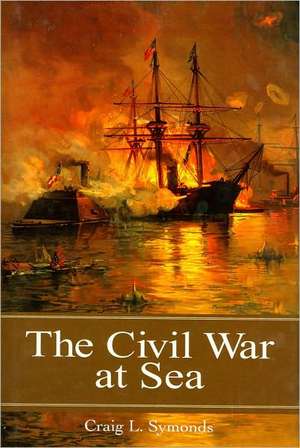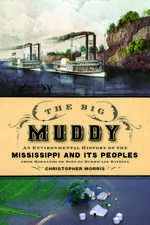The Civil War at Sea: Reflections on the Civil War Era
Autor Craig L. Symondsen Limba Engleză Hardback – 24 aug 2009 – vârsta până la 17 ani
| Toate formatele și edițiile | Preț | Express |
|---|---|---|
| Paperback (1) | 238.68 lei 3-5 săpt. | |
| Oxford University Press – 11 oct 2012 | 238.68 lei 3-5 săpt. | |
| Hardback (1) | 307.47 lei 6-8 săpt. | |
| Bloomsbury Publishing – 24 aug 2009 | 307.47 lei 6-8 săpt. |
Preț: 307.47 lei
Preț vechi: 374.84 lei
-18% Nou
Puncte Express: 461
Preț estimativ în valută:
58.84€ • 63.89$ • 49.43£
58.84€ • 63.89$ • 49.43£
Carte tipărită la comandă
Livrare economică 22 aprilie-06 mai
Preluare comenzi: 021 569.72.76
Specificații
ISBN-13: 9780275990848
ISBN-10: 0275990842
Pagini: 212
Dimensiuni: 156 x 235 x 23 mm
Greutate: 0.48 kg
Editura: Bloomsbury Publishing
Colecția Praeger
Seria Reflections on the Civil War Era
Locul publicării:New York, United States
ISBN-10: 0275990842
Pagini: 212
Dimensiuni: 156 x 235 x 23 mm
Greutate: 0.48 kg
Editura: Bloomsbury Publishing
Colecția Praeger
Seria Reflections on the Civil War Era
Locul publicării:New York, United States
Caracteristici
Extensive bibliography of contemporary and archival resources in print and online
Notă biografică
Craig L. Symonds is professor emeritus at the U.S. Naval Academy, and the author of 11 previous books on the Civil War and naval history, including the Lincoln-Prize-winning Lincoln and His Admirals.
Cuprins
Series ForewordPrefaceChapter One: The Ships and the Guns: Civil War Navies and the Technological RevolutionChapter Two: The Blockade and Blockade RunnersChapter Three: The War on Commerce: The Hunters and the HuntedChapter Four: "Unvexed to the Sea": The River WarChapter Five: Civil War Navies and the Siege of CharlestonChapter Six: The End Game: Mobile, Wilmington, and the Cruise of the ShenandoahNotesBibliographical EssayIndex
Recenzii
Symonds writes briskly and with great competence, and The Civil War at Sea (and on the rivers) is a masterful overview of a most meaningful topic.
The role of ships during the Civil War is, for most people, confined to the blockade of the cotton exports in the Carolinas and the battle between the ironclads Monitor and Merrimac. Symonds (American History, U.S. Naval Academy, Annapolis MD, emeritus) covers both these subjects and much more. Steam engines and iron-plated hulls were new technologiesat the time, changing the context of sea battles. The encounters are chronicled, with maps and diagrams and the strategic side of the war at sea is explained. However, Symonds also recreates the personalities of the seamen from admirals to deckhands. One lesser known tactic that he discusses is the Confederate response to the blockade, which was thehonored tradition of privateering. Union merchant ships were attacked off the coast of France and England. The Shenandoah sailed literally around the world, hampering trade as far as China and Japan. Symonds presents a side of Civil War history rarely, if ever, included in Civil War accounts.
There was a time only several decades past when new histories of the blue-and-brown water US Civil War were hardto come by. Students and others seeking details of the naval or riverine operations of the great conflict were forced torely on old standbys published at the end of the 19th century, some memoirs, several rather popular chronicles, and theNavy official records. Now, within a span of three years, two excellent operational histories have appeared, both demonstrating the impact of the sea services upon the outcome of the struggle. The first was Spencer C. Tucker'sBlue & Gray Navies: The Civil War Afloat (2006) and the other is this work, from the prize-winning author of lastyear's Lincoln and His Admirals (2008). Crisp writing, incisive assessments of leading personalities, and attention to details often overlooked enhance Symonds's book. The author footnotes each of the six chapters, includes good maps, and provides the obligatory photos needed for a Civil War title. A bibliographical essay completes the concise survey. Summing Up: Highly recommended. Undergraduates and Civil War buffs.
Symonds' account of the campaigns, strategies, tactics, and personalities that characterized the naval conflict is both detailed and comprehensible for laypersons. He effectively places the naval war within the broader context of an emerging industrial age, as steam and steel led to great changes in the construction and use of warships. The author uses a topical approach, with his descriptions of the Union blockade and Confederate efforts to thwart it particularly interesting. A good addition to Civil War collections.
The role of ships during the Civil War is, for most people, confined to the blockade of the cotton exports in the Carolinas and the battle between the ironclads Monitor and Merrimac. Symonds (American History, U.S. Naval Academy, Annapolis MD, emeritus) covers both these subjects and much more. Steam engines and iron-plated hulls were new technologiesat the time, changing the context of sea battles. The encounters are chronicled, with maps and diagrams and the strategic side of the war at sea is explained. However, Symonds also recreates the personalities of the seamen from admirals to deckhands. One lesser known tactic that he discusses is the Confederate response to the blockade, which was thehonored tradition of privateering. Union merchant ships were attacked off the coast of France and England. The Shenandoah sailed literally around the world, hampering trade as far as China and Japan. Symonds presents a side of Civil War history rarely, if ever, included in Civil War accounts.
There was a time only several decades past when new histories of the blue-and-brown water US Civil War were hardto come by. Students and others seeking details of the naval or riverine operations of the great conflict were forced torely on old standbys published at the end of the 19th century, some memoirs, several rather popular chronicles, and theNavy official records. Now, within a span of three years, two excellent operational histories have appeared, both demonstrating the impact of the sea services upon the outcome of the struggle. The first was Spencer C. Tucker'sBlue & Gray Navies: The Civil War Afloat (2006) and the other is this work, from the prize-winning author of lastyear's Lincoln and His Admirals (2008). Crisp writing, incisive assessments of leading personalities, and attention to details often overlooked enhance Symonds's book. The author footnotes each of the six chapters, includes good maps, and provides the obligatory photos needed for a Civil War title. A bibliographical essay completes the concise survey. Summing Up: Highly recommended. Undergraduates and Civil War buffs.
Symonds' account of the campaigns, strategies, tactics, and personalities that characterized the naval conflict is both detailed and comprehensible for laypersons. He effectively places the naval war within the broader context of an emerging industrial age, as steam and steel led to great changes in the construction and use of warships. The author uses a topical approach, with his descriptions of the Union blockade and Confederate efforts to thwart it particularly interesting. A good addition to Civil War collections.
Descriere
Descriere de la o altă ediție sau format:
Continuing in the vein of his Lincoln Prize-winning book Lincoln and His Admirals, acclaimed naval historian Craig L. Symonds presents a masterful history of the Civil War navies--both Union and Confederate--and places them within the broader context of the emerging industrial age. Symonds begins with an account of the dramatic pre-war revolution in naval technology--the advent of steam propulsion, the screw propeller, and larger and more powerful rifled guns that could fire explosive shells as well as solid shot. These extraordinary changes were epitomized in the famous "Battle of the Ironclads"--one of the great stories of the Civil War--pitting USS Monitor against the larger and more heavily armed CSS Virginia (also known as Merrimack). Symonds also offers an overview of Lincoln's blockade of the South, a vast campaign involving as many as 500 ships and 100,000 men; discusses the fierce naval war for control of the rivers in the West; and looks at the important siege of Charleston, which would last three years and involve 40,000 men and sixty warships. Symonds concludes with three key episodes from the end of the war--the dramatic Battle of Mobile Bay, where Farragut delivered his famous cry: "Damn the torpedoes! Full speed ahead!"; the battle of Wilmington, where combined naval and army forces successfully overran Fort Fisher, a giant earthwork fort called by one historian "the mightiest fortress in America"; and the remarkable cruise of the CSS Shenandoah, a round-the-world voyage of 58,000 miles, during which she captured thirty-eight prizes--mostly after Lee had surrendered, alas. The Civil War at Sea illuminates a little-discussed and greatly undervalued aspect of America's national conflict. Concise yet comprehensive, this volume is a lively addition to the field of naval history.
Continuing in the vein of his Lincoln Prize-winning book Lincoln and His Admirals, acclaimed naval historian Craig L. Symonds presents a masterful history of the Civil War navies--both Union and Confederate--and places them within the broader context of the emerging industrial age. Symonds begins with an account of the dramatic pre-war revolution in naval technology--the advent of steam propulsion, the screw propeller, and larger and more powerful rifled guns that could fire explosive shells as well as solid shot. These extraordinary changes were epitomized in the famous "Battle of the Ironclads"--one of the great stories of the Civil War--pitting USS Monitor against the larger and more heavily armed CSS Virginia (also known as Merrimack). Symonds also offers an overview of Lincoln's blockade of the South, a vast campaign involving as many as 500 ships and 100,000 men; discusses the fierce naval war for control of the rivers in the West; and looks at the important siege of Charleston, which would last three years and involve 40,000 men and sixty warships. Symonds concludes with three key episodes from the end of the war--the dramatic Battle of Mobile Bay, where Farragut delivered his famous cry: "Damn the torpedoes! Full speed ahead!"; the battle of Wilmington, where combined naval and army forces successfully overran Fort Fisher, a giant earthwork fort called by one historian "the mightiest fortress in America"; and the remarkable cruise of the CSS Shenandoah, a round-the-world voyage of 58,000 miles, during which she captured thirty-eight prizes--mostly after Lee had surrendered, alas. The Civil War at Sea illuminates a little-discussed and greatly undervalued aspect of America's national conflict. Concise yet comprehensive, this volume is a lively addition to the field of naval history.


























